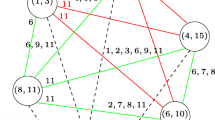Abstract
We consider dissimilarities which are defined only on some pairs of items. Such situations may occur in some problems like unfolding or merging, or can be encountered as an intermediate step of a more general transformation. We give necessary and sufficient conditions for the existence of extensions with good properties and characterize the family of such extensions. Using partial dissimilarities we construct a dissimilarity-into-distance transformation family.
Résumé
On s'intéresse aux dissimilarités qui ne sont définies que sur certaines paires d'éléments. Cette situation se rencontre dans certains types de problèmes tel que les déploiments ou les mélanges. Elle peut également intervenir comme une étape intermédiaire d'une transformation plus générale. On donne des conditions nécessaires et suffisantes pour qu'il existe des extensions ayant de bonnes propriétés et on caractérise la famille obtenue. Par l'intermédiaire des dissimilarités partielles on construit une famille de transformation d'une dissimilarité en une distance.
Similar content being viewed by others
References
BLUMENTHAL, L. M. (1953),Theory and Applications of Distance Geometry, Oxford: Clarendon Press.
BRADFIELD, G. E., and KENKEL, N. C. (1987), “Non Linear Ordination Using Flexible Shortest Path Adjustment of Ecological Distances,”Ecology, 69, 750–753.
BROSSIER, G. (1986), “Etude des matrices de proximité rectangulaires en vue de la classification,”Revue de Statistiques Appliquées, XXXV, 43–68.
BROSSIER, G. (1990), “Piecewise Hierarchical Clustering,”Journal of Classification, 7, 197–216.
COOMBS, C. H. (1964),A Theory of Data, New York: Wiley.
DE SOETE, G., DESARBO, W. S., FURNAS, G. W., and CARROLL, J. D. (1984), “The Estimation of Ultrametric and Path Length Trees from Rectangular Proximity Data,”Psychometrika, 49, 289–310.
JAMBU, M., and LEBEAUX, M. O. (1983),Cluster Analysis and Data Analysis, Amsterdam: North-Holland.
GORDON, A. D. (1986). “Consensus Supertrees: The Synthesis of Rooted Trees Containing Overlapping Sets of Labeled Leaves,”Journal of Classification, 3, 335–348.
GOWER, J. C. (1968), “Adding a Point to Vector Diagrams in Multivariate Analysis,”Biometrika, 55, 582–585.
GRAEF, J., and SPENCE, I. (1979), “Using Distance Information in the Design of Large Multidimensional Scaling Experiments,”Psychological Bulletin, 86, 60–66.
KRUSKAL, J. B. (1964a), “Multidimensional Scaling by Optimizing Goodness of Fit to a Nonmetric Hypothesis,”Psychometrika, 29, 1–27.
KRUSKAL, J. B. (1964b), “Nonmetric Multidimensional Scaling: A Numerical Method,”Psychometrika, 29, 115–129.
LEFKOVITCH, L. P. (1989), “A Non-metric Procedure for Transforming Dissimilarities to Euclidean Distances Useful in Numerical Taxonomy and Ecology,”Biometrical Journal, 31, 525–543.
MURTAGH, F. (1985), “A Survey of Algorithms for Contiguity-Constrained Clustering and Related Problems,”The Computer Journal, 28, 82–88.
SHEPARD, R. N., and CARROLL, J. D. (1966), “Parametric Representation of Nonlinear Data Structures,”Multivariate Analysis, Ed., Krishnaiah, Academic Press, 561–592.
TOUSSAINT, G. T. (1980), “The Relative Neighborhood Graph of a Finite Planar Set,”Pattern Recognition, 12, 261–268.
WILLIAMSON, M. H. (1978), “The Ordination of incidence Data,”Journal of Ecology, 66, 911–920.
ZUPAN, J. (1982),Clustering of Large Data Sets, Lechtworth: Research Studies Press.
Author information
Authors and Affiliations
Additional information
The author thanks the editor and two anonymous referees for their suggestions and their helpful comments.
Rights and permissions
About this article
Cite this article
Brossier, G. Partial dissimilarities with application to clustering. Journal of Classification 11, 37–58 (1994). https://doi.org/10.1007/BF01201022
Issue Date:
DOI: https://doi.org/10.1007/BF01201022




